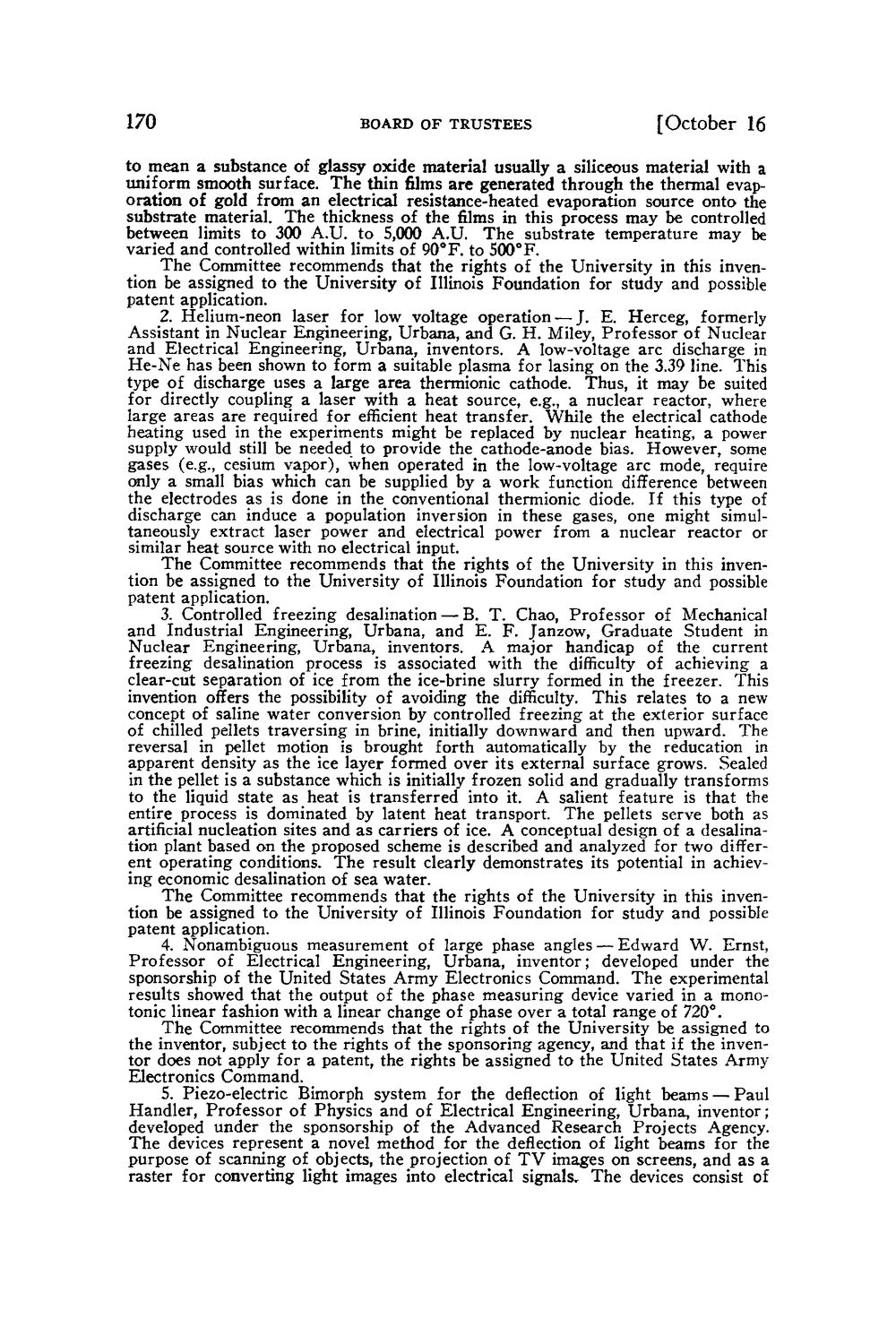| |
| |
Caption: Board of Trustees Minutes - 1970
This is a reduced-resolution page image for fast online browsing.

EXTRACTED TEXT FROM PAGE:
170 BOARD OF TRUSTEES [October 16 to mean a substance of glassy oxide material usually a siliceous material with a uniform smooth surface. T h e thin films are generated through the thermal evaporation of gold from an electrical resistance-heated evaporation source onto the substrate material. The thickness of the films in this process may be controlled between limits to 300 A.U. to 5,000 A.U. T h e substrate temperature may be varied and controlled within limits of 90°F. to 500°F. T h e Committee recommends that the rights of the University in this invention be assigned to the University of Illinois Foundation for study and possible patent application. 2. Helium-neon laser for low voltage operation — J . E. Herceg, formerly Assistant in Nuclear Engineering, Urbana, and G. H. Miley, Professor of Nuclear and Electrical Engineering, Urbana, inventors. A low-voltage arc discharge in He-Ne has been shown to form a suitable plasma for lasing on the 3.39 line. This type of discharge uses a large area thermionic cathode. Thus, it may be suited for directly coupling a laser with a heat source, e.g., a nuclear reactor, where large areas are required for efficient heat transfer. While the electrical cathode heating used in the experiments might be replaced by nuclear heating, a power supply would still be needed to provide the cathode-anode bias. However, some gases (e.g., cesium vapor), when operated in the low-voltage arc mode, require only a small bias which can be supplied by a work function difference between the electrodes as is done in the conventional thermionic diode. If this type of discharge can induce a population inversion in these gases, one might simultaneously extract laser power and electrical power from a nuclear reactor or similar heat source with no electrical input. The Committee recommends that the rights of the University in this invention be assigned to the University of Illinois Foundation for study and possible patent application. 3. Controlled freezing desalination — B. T. Chao, Professor of Mechanical and Industrial Engineering, Urbana, and E. F . Janzow, Graduate Student in Nuclear Engineering, Urbana, inventors. A major handicap of the current freezing desalination process is associated with the difficulty of achieving a clear-cut separation of ice from the ice-brine slurry formed in the freezer. This invention offers the possibility of avoiding the difficulty. This relates to a new concept of saline water conversion by controlled freezing at the exterior surface of chilled pellets traversing in brine, initially downward and then upward. The reversal in pellet motion is brought forth automatically by the reducation in apparent density as the ice layer formed over its external surface grows. Sealed in the pellet is a substance which is initially frozen solid and gradually transforms to the liquid state as heat is transferred into it. A salient feature is that the entire process is dominated by latent heat transport. The pellets serve both as artificial nucleation sites and as carriers of ice. A conceptual design of a desalination plant based on the proposed scheme is described and analyzed for two different operating conditions. The result clearly demonstrates its potential in achieving economic desalination of sea water. T h e Committee recommends that the rights of the University in this invention be assigned to the University of Illinois Foundation for study and possible patent application. 4. Nonambiguous measurement of large phase angles — Edward W. Ernst, Professor of Electrical Engineering, Urbana, inventor; developed under the sponsorship of the United States Army Electronics Command. The experimental results showed that the output of the phase measuring device varied in a monotonic linear fashion with a linear change of phase over a total range of 720°. The Committee recommends that the rights of the University be assigned to the inventor, subject to the rights of the sponsoring agency, and that if the inventor does not apply for a patent, the rights be assigned to the United States Army Electronics Command. 5. Piezo-electric Bimorph system for the deflection of light beams — Paul Handler, Professor of Physics and of Electrical Engineering, Urbana, inventor; developed under the sponsorship of the Advanced Research Projects Agency. T h e devices represent a novel method for the deflection of light beams for the purpose of scanning of objects, the projection of T V images on screens, and as a raster for converting light images into electrical signals. The devices consist of
| |